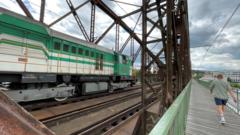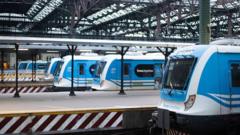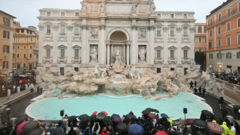In one of Europe’s historically rich cities, Prague stands as a vibrant mostly intact example of various architectural styles that draw approximately 8 million tourists annually. The imminent replacement of the Vysehrad railway bridge, a structure steeped in history and integral to the city’s skyline, has stirred significant objections amongst residents and experts alike.
Petr Tej, a bridge engineer affiliated with the Vysehrad Bridge Foundation, asserts that the existing bridge can be restored rather than replaced entirely. "The panorama it forms with the Vysehrad fortress is crucial to Prague,” he stated passionately, while inspecting the weathered steel. Tej is joined by over 25,000 residents who have signed a petition advocating for the preservation of the bridge, a structure built during the Austro-Hungarian Empire in 1902.
Their proposal suggests fixing the existing structure instead of pulling it down, which they estimate would require only 15% of the materials to be replaced, contrary to the Railway Authority’s assertion that 70% needs replacement. The Vysehrad Bridge Foundation claims this restoration would not only maintain historical integrity but also keep rail traffic operational with minimal disruption.
However, the Railway Authority, represented by Pavel Paidar, presents a contrasting viewpoint. He argues that the bridge’s deteriorating state limits its capacity to handle current rail traffic, posing challenges amidst projected growth. The proposed new bridge aims to support a third track and promises revitalization of transit links in the area, while also initiating the bridge’s relocation to Modrany as a new space for pedestrians and cyclists.
Despite this, modernizing efforts raise concerns from campaigners regarding the suitability of placing the bridge in an area markedly different than its historical urban context. They criticize the plan’s shortcomings, fearing it could disrupt the aesthetic coherence of the region.
The dilemma echoes through cities worldwide: should modern needs surpass considerations for historical preservation? In Prague, a city that takes pride in its architectural lineage, this question becomes pressing, potentially resting in the hands of the Czech government to determine the future trajectory of the Vysehrad railway bridge.
Petr Tej, a bridge engineer affiliated with the Vysehrad Bridge Foundation, asserts that the existing bridge can be restored rather than replaced entirely. "The panorama it forms with the Vysehrad fortress is crucial to Prague,” he stated passionately, while inspecting the weathered steel. Tej is joined by over 25,000 residents who have signed a petition advocating for the preservation of the bridge, a structure built during the Austro-Hungarian Empire in 1902.
Their proposal suggests fixing the existing structure instead of pulling it down, which they estimate would require only 15% of the materials to be replaced, contrary to the Railway Authority’s assertion that 70% needs replacement. The Vysehrad Bridge Foundation claims this restoration would not only maintain historical integrity but also keep rail traffic operational with minimal disruption.
However, the Railway Authority, represented by Pavel Paidar, presents a contrasting viewpoint. He argues that the bridge’s deteriorating state limits its capacity to handle current rail traffic, posing challenges amidst projected growth. The proposed new bridge aims to support a third track and promises revitalization of transit links in the area, while also initiating the bridge’s relocation to Modrany as a new space for pedestrians and cyclists.
Despite this, modernizing efforts raise concerns from campaigners regarding the suitability of placing the bridge in an area markedly different than its historical urban context. They criticize the plan’s shortcomings, fearing it could disrupt the aesthetic coherence of the region.
The dilemma echoes through cities worldwide: should modern needs surpass considerations for historical preservation? In Prague, a city that takes pride in its architectural lineage, this question becomes pressing, potentially resting in the hands of the Czech government to determine the future trajectory of the Vysehrad railway bridge.





















